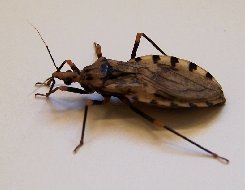



Conenose or Kissing bug

Name: Conenose bugs, kissing bugs, assassin bugs or triatomines
Size: A wingless first instar nymph hatches from an egg. About the size of the tip of a fork. It passes successively through 2nd, 3rd, 4th and 5th instars. Finally, the fifth instar turns into an adult, acquiring two pair of wings.
Habitat: They are mainly found and widespread in the Americas,These bugs usually share shelter with nesting vertebrates, from which they suck blood. In areas where Chagas disease occurs (from the southern United States to southern Argentina), all triatomine species are potential vectors of the Chagas disease. Most species are associated with wild nesting vertebrates.These live in ground burrows with rodents, or in tree-dwellings with bats, birds. Few species (5%) live in human dwellings or in the surroundings of human houses.
Danger:
Domestic and sylvatic species can carry the Chagas parasite to humans and wild mammals; birds are immune to the parasite. T. cruzi transmission is carried mainly from human to human by domestic kissing bugs; from the vertebrate to the bug by blood, and from the bug to the vertebrate by the insect's feces and not by its saliva as occurs in most bloodsucking arthropod vectors. Triatomine infestation especially affects unkempt dwellings. One can recognize the presence of triatomines in a house by its feces, exuviae, eggs and individuals themselves.
Some Links to information about kissing bugs:
- The Kiss of Death, University of Texas, Arlington.
Photo Credits:
Conenose/Kissing bug - Fernando Otálora Luna (GNU Free Documentation License)The information on this page was taken from Wikipedia under a GNU Free Documentation License unless otherwise noted.









